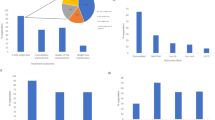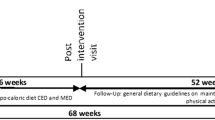Abstract
OBJECTIVE: To describe a combined behavioural treatment program for obese men, the `Gustaf' study, and to evaluate treatment success by the means of weight loss, drop-out analysis and changes in metabolic risk factors. SUBJECTS: Eighty-six men, aged 43±9 y (mean±s.d.) and BMI 37.7±4.4 kg/m2, from the waiting list of the outpatient clinic and men directly approaching the Obesity Unit. DESIGN: Combined, behavioural modification treatment, by the means of group sessions, for one hour every week over a two year period. MAIN OUTCOME MEASURES: Weight loss and changes in risk factors after completion of one and two years study and description of treatment success in the form of changes in metabolic risk factors. RESULTS: The one year drop-out rate was 22% and the cumulative rate after two years was 34%. Mean weight decreased significantly from start (121 kg) to one year (114 kg, P<0.001) and to two years (115 kg, P<0.001) in completers. Several metabolic risk factors (waist and hip circumferences, systolic blood pressure, serum cholesterol and plasma insulin) remained significantly decreased after two years of treatment. The complete metabolic syndrome was diagnosed in five men at onset, but in no one after two years. There was no difference in change of metabolic risk factors after one year between the men who lost 8–12% of initial body weight and those who lost more. CONCLUSION: Sixty-six% (57/86) of the obese men who started in the `Gustaf' program were still in the program after two years. In spite of the relatively modest weight loss, the men maintained a large proportion of this weight loss and also maintained their improved metabolic risk factor pattern.
This is a preview of subscription content, access via your institution
Access options
Subscribe to this journal
Receive 12 print issues and online access
$259.00 per year
only $21.58 per issue
Buy this article
- Purchase on Springer Link
- Instant access to full article PDF
Prices may be subject to local taxes which are calculated during checkout
Similar content being viewed by others
Author information
Authors and Affiliations
Rights and permissions
About this article
Cite this article
Andersson, I., Rössner, S. Weight development, drop-out pattern and changes in obesity-related risk factors after two years treatment of obese men. Int J Obes 21, 211–216 (1997). https://doi.org/10.1038/sj.ijo.0800389
Received:
Revised:
Accepted:
Issue Date:
DOI: https://doi.org/10.1038/sj.ijo.0800389
Keywords
This article is cited by
-
How do overweight people dropout of a weight loss diet? A qualitative study
BMC Nutrition (2021)
-
Development of a Measure of Barriers to Laparoscopic Adjustable Gastric Banding (LAGB) Aftercare Attendance
Obesity Surgery (2016)
-
Obesity treatment in elderly outpatients: Predictors of efficacy and drop-out
Eating and Weight Disorders - Studies on Anorexia, Bulimia and Obesity (2009)
-
Multidisciplinary approach to obesity
Eating and Weight Disorders - Studies on Anorexia, Bulimia and Obesity (2009)
-
Should snacks be recommended in obesity treatment? a 1-year randomized clinical trial
European Journal of Clinical Nutrition (2008)



